When the grass-cutting season comes around, maintaining a clean lawn becomes a chore. And although regular lawn care is essential, it can get tedious. Do not worry, though! There is a solution! And that is where lawn mowing patterns techniques come in!
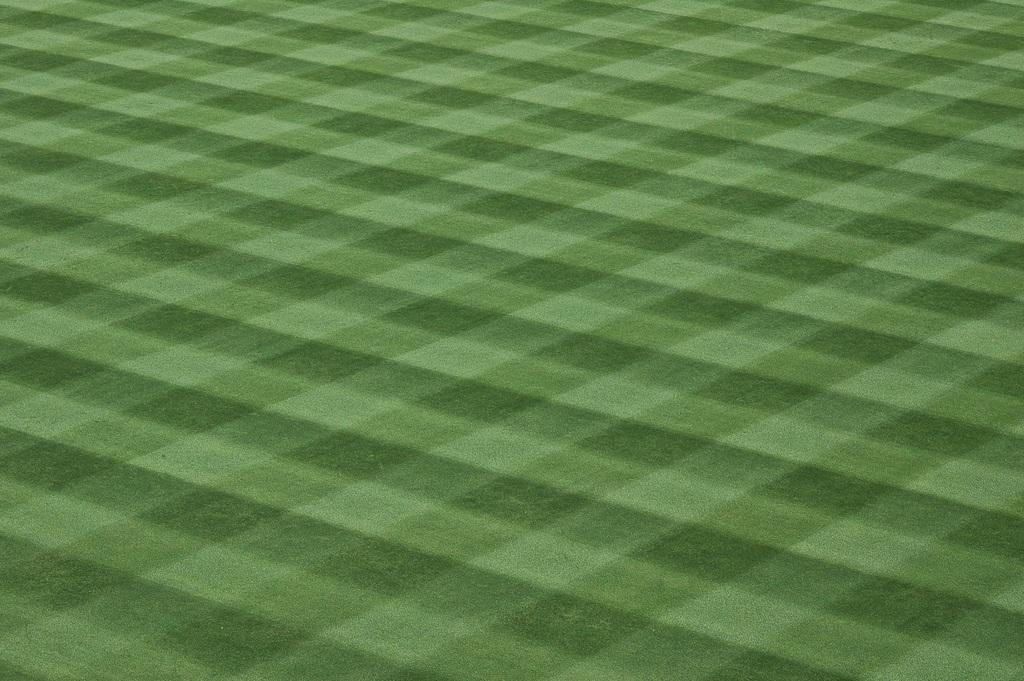
Simple or complex, alternating mowing patterns are good for your lawn.
While a lawn mowing pattern may sound fancy and unneeded, you create a pattern every time you mow the lawn. Altering this pattern of cutting the grass on a lawn is done not only for aesthetics but also for maintaining the health of a yard.
So, if you are someone who has always been jealous of those striped patterns on your neighbor’s lawn and wanted to know how to create them, this article is for you!
Learning the basic lawn mowing techniques will make your yard look fantastic while also benefiting the grass. You don’t even need to have special equipment or spend a lot of time learning how to create patterns on your grass.
It all comes down to being deliberate about how you mow the grass on your lawn.
Continue reading. I will tell you all you need to know about using several grass-cutting techniques to make those neat, straight lines in your yard, just like a pro!
Why Use Lawn Mowing Patterns?
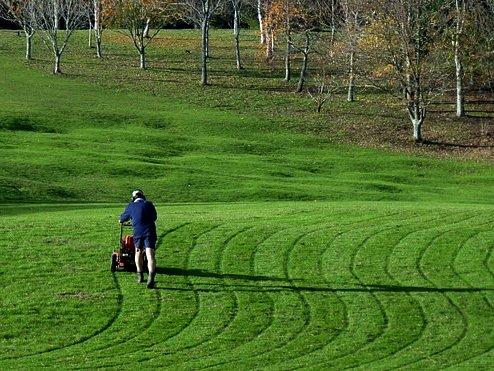
Lawn mowing patterns are more than just eye-catching designs; they also benefit your lawn.
You don’t have to be obsessed with having the ideal lawn to use mowing patterns. Even if you don’t care about having patterns in your grass, it’s still important to watch how you mow.
Mowing the lawn in the same pattern again and over destroys the grass in the tire tracks. This results in bare patches where weeds can establish themselves. Therefore, to reduce such an impact, the grass should be cut such that the tires go on a different track each time.
Believe it or not, mowing your lawn in patterns has advantages other than just giving you the coolest-looking yard on the block. Some of these advantages are described below.
Related: Grass Types That Do Not Require Mowing & Best No-Mow Grass Alternatives
They Hide Flaws In Your Yard
Every lawn has some sort of flaw. Whether uneven ground, a distinct dead zone, or a weed patch, there is a flaw. Mowing your grass in patterns can easily conceal these few minor flaws in your lawn. Lawn patterns create the illusion of a pristine lawn and trick the observer.
For instance, these lovely stripes have long been used to create the illusion of a perfect lawn on seemingly perfect golf courses and sports fields.
They Improve The Overall Health Of Your Lawn
The grass needs to be cut at a higher height if you want to create stripes or patterns on your lawn. And, grass that is allowed to grow tall has a robust and extensive root system below ground that can survive dry periods better.
When you cut the grass low using your mower, the grass blade becomes short.
With decreased surface area, the grass absorbs less sunlight, reducing photosynthesis and, as a result, the food prepared by the plant, which in turn weakens the lawn.
They Reduce Overtime Lawn Damage
Repeatedly using the same mowing pattern or stripe compacts the soil, affecting grass health. Compacted soil prevents the free passage of water, air, and nutrients.
Moreover, frequent use of the same paths for mowing can thin your grass in certain areas.
Changing mowing patterns can reduce mower tire wear and avoid compacting the lawn. This keeps the grass growing at its best while allowing plenty of air, water, and nutrient flow.
What Pattern Should I Choose For My Lawn?
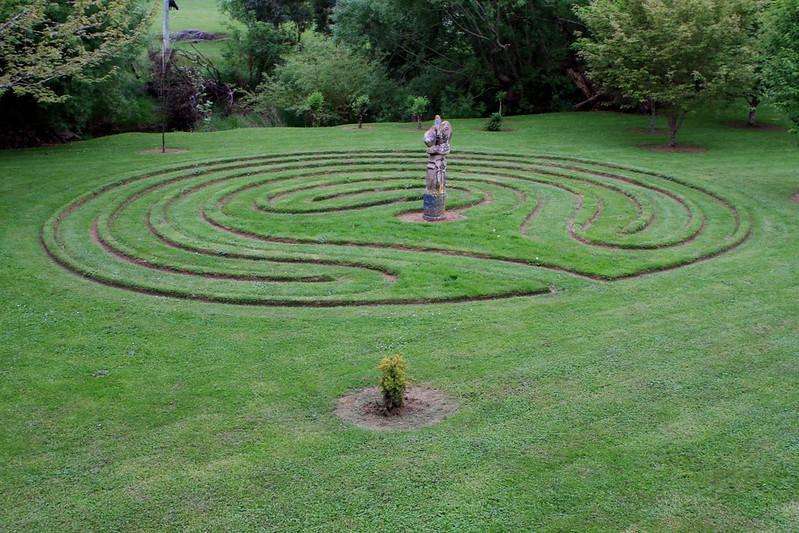
Cool-season grasses bend more than warm-season grasses and create more enticing lawn stripes & patterns.
It all depends on how much time and effort you are willing to put into it and whether you want to stick to the fundamentals of switching up your lawn mowing pattern or create a design that is the envy of the neighborhood.
No one pattern will work perfectly on every lawn. Personally, I try to keep things interesting by switching things up!
However, I have a large square yard, so I have plenty of space to try out new things. If yours is oddly shaped or small, only one or two of the designs might work.
Consider Your Grass Type
Regarding lawn mowing patterns, not all types of grass are made equal. The more grass bends, the more visually appealing the patterns become.
For instance, the aesthetic benefits of striping are often less noticeable in warm-season grasses because warm-season grasses are more inflexible and bend less than cold-season grasses.
Related: Planting, Mowing And Watering Bermuda Grass Lawn | How To Do It Right?
How Do Lawn Patterns Work?

The patterns you see on lawns are just a manipulation of how light reflects on grass blades.
The appearance of a pattern is heavily influenced by the angle from which it is viewed.
Grass blades bent away from you appear lighter because they have a bigger blade surface that reflects light, whereas blades turned in your direction appear darker because they have a smaller blade surface that reflects light.
True ballpark-worthy grass patterns can easily be achieved with a bending attachment on your mower or a lawn roller.
However, you can also accomplish it by dragging your lawnmower across the turf. The pattern won’t be as clearly defined, but it will be there to create the illusion.
The Best Lawn Mowing Patterns
Here are some of the best patterns for mowing your lawn, which will not only help your grass stay in a wonderful form but will also demonstrate your artistic ability to your neighbors.
In addition, I will begin with lawn mowing patterns that are the most basic and standard first, and then I will move on to the complex and tricky ones.
Stripes Or Rows
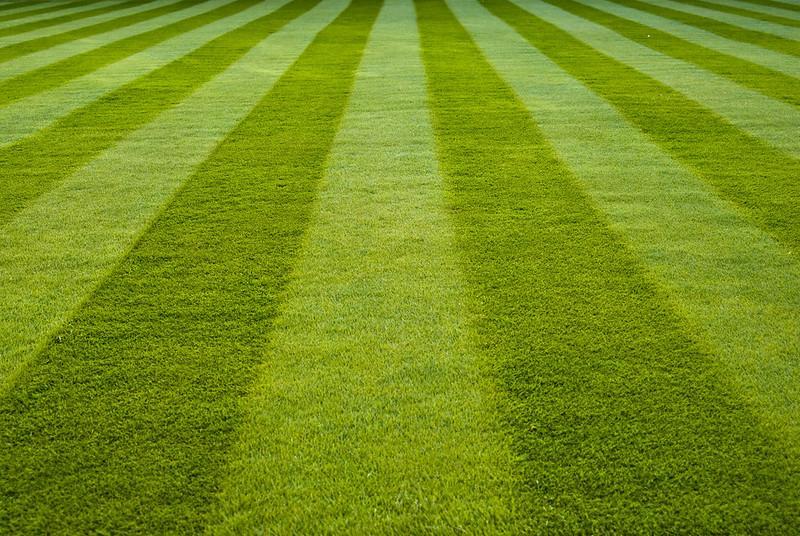
Lawn striping is a great finishing touch to a great and healthy lawn.
Stripes have become a standard feature of suburban home grass mowing. Creating stripes is the most fundamental and easy pattern for mowing a lawn, and it should be chosen when time is of the essence.
Stripes or rows produce a high-contrast design that is simple to implement and can alter your boring lawn overnight.
How To Create Stripes On A Lawn?
- Draw a rough outline of your garden and decide where you want your stripes to go.
- Next, raise the cutting height on your mower to its highest setting, and work your way around one edge of the grass at a right angle.
- Following that, mow the next rows or stripes in the opposite direction from the previous stripe each time, but stay parallel.
- Also, instead of making abrupt bends, mow the grass using a Y-shaped pattern.
You are free to switch up the pattern; it does not have to be parallel to the house. For instance, you can mow the stripes diagonally if you want.
Related: What Is The Best Mowing Season, Height & Frequency For Bermuda Grass?
Checkerboard
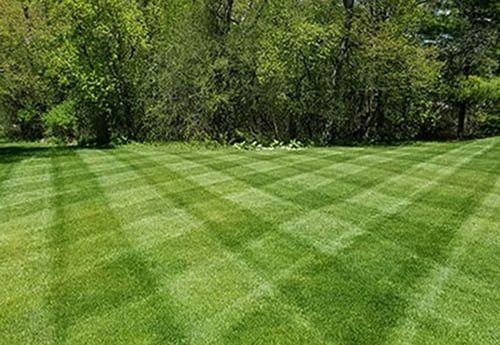
With a checkerboard lawn, you’ll be the focus of everyone else’s envy in the neighborhood.
After you’ve mastered typical lawn striping patterns, it’s time to try your hand at the checkerboard. The checkerboard effect is produced when grass blades twist in different directions and reflect light, appearing darker and brighter.
If you want your yard to look like a baseball park, then this is the pattern that you should choose.
How To Mow Checkerboard Patterns Into Your Grass?
- Mow the grass in one direction, say, from north to south till one end of the lawn, and then make a parallel cut from south to north.
- The end outcome will be one lighter stripe that runs parallel to one darker stripe.
- Keep doing this until the entire lawn is mowed before moving on to the next step.
- Now, change orientation and mow at an angle perpendicular to what you just did—mow up west to east, back down east to west, and so on.
Diamond
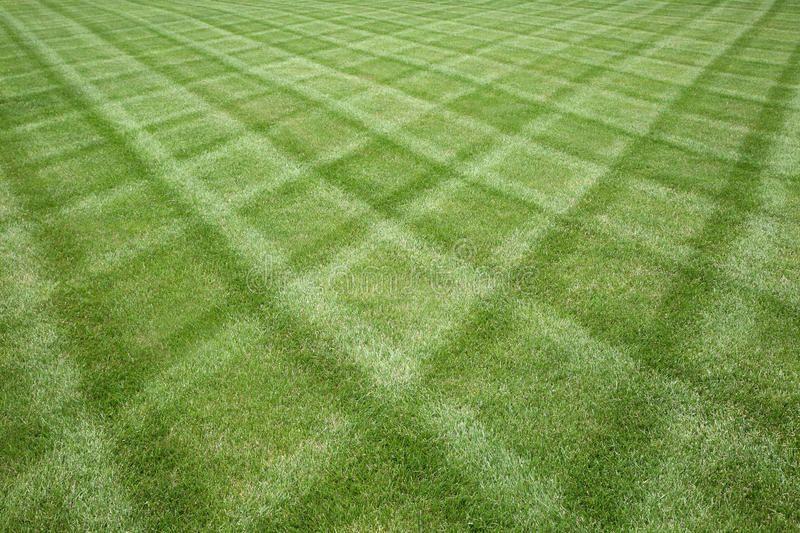
Mowing through the striped patterns diagonally produces diamond patterns on the lawn.
Another lawn mowing design commonly seen in sports fields is the diamond pattern. The diamond pattern can be applied to virtually any lawn with sufficient preparation, experience, and perseverance.
But let’s be honest: the more level and symmetrical your yard is, the more attractive it will look when mowed in a diamond pattern.
How To Mow Diamond Patterns On Your Lawn?
- Start by cutting diagonally with the lawnmower between two of the lawn’s corners and then make another pass in the same direction.
- Now, proceed to the opposite end of your grass and mow a stripe in the opposite direction directly next to the first diagonal stripes.
- Once the first set of diagonal stripes is finished, create a single diagonal stripe between the lawn’s remaining two corners.
- In this manner, continue the single- and double-stripe diagonal pattern until you reach the edge of the lawn, and then you are done!
Waves Or Curves

Creating lawn mowing designs can make mowing a more fun lawn chore!
There is no need for lines to be absolutely straight. Curves or waves are a type of stripe that uses a pleasant curving pattern instead of going straight.
The wave pattern is primarily determined by your ability to create clean, pleasing wavy stripes across the entire length of your lawn. It won’t be easy, and it will definitely take some practice.
How Do I Create Waves On My Lawn?
- Mow a reference stripe straight down the middle of the grass after the obligatory pass around the perimeter.
- Next, use the center line as a guide to create a wavy return line rather than turning around and returning straight back.
- You can make your wave as tight or as loose as you like. However, it will be simpler if there are fewer swings in the wave.
- Use the first wave as a guide. When you reach the edge, perform a slight 180-degree turn and proceed in the opposite way.
- Continue with the steps mentioned above until you are done!
Circles
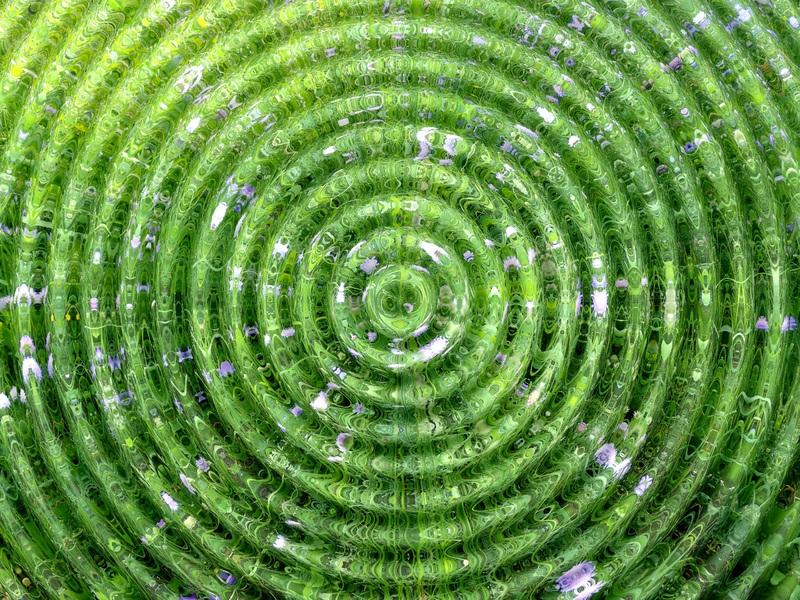
Mowing concentric circles are efficient because all the turns are in the same direction.
A circle design can be started from the outside or the inside. You can start inside and work out to the edge if you have a tree or another focal point in the middle of your lawn. However, for a yard with no focus points, it is advisable to begin on the outside.
How To Create A Circle Pattern On Your Lawn?
- Start by choosing the center of your circle and insert a cane there. Following that, attach a string to the inserted rod.
- Next, grab the other end of the line and tie it to a spray paint can. Then, start walking in a circle while sprinkling paint and keeping the line in tension.
- After that, make a path around your lawn with your mower by following this circle of spray paint that you have drawn as a guide.
- When you’re finished, use the initial circle you mowed as a guide to create concentric circles of cut grass on your lawn.
Arches Or Zig-zag
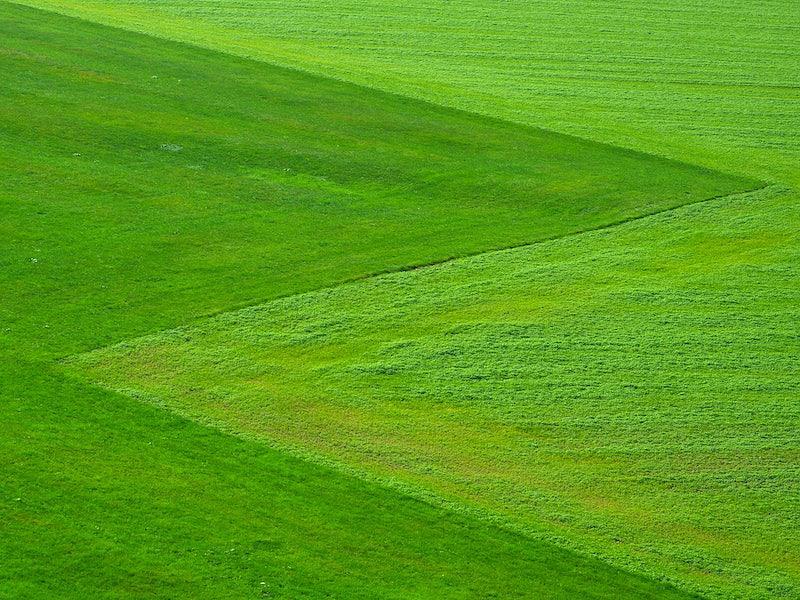
The zig-zag pattern on the lawn looks great, but it is challenging to create and takes a lot of practice.
The zig-zag pattern takes a lot of time and effort to create, but it offers your lawn a really distinct look. Depending on how you want the zig-zag design to appear, start by making a checkerboard or criss-cross stripe pattern. This will provide you with a guide that you may use as a template for your zig-zag design.
How To Create A Zig-zag Pattern On Your Lawn?
- Begin by cutting the grass along the border of your lawn.
- Next, spin the mower around and cut the grass in a zig-zag pattern across the yard.
- It is imperative that you overlap each pass to ensure that no areas are overlooked.
- When at the opposite end, turn around and mow back across it in the opposite way.
- Continue cutting in this fashion until the lawn is finished.
Varying Lines
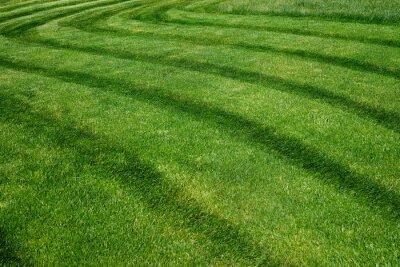
These line patterns are for those who are lazy and do not want to put in much effort.
You can produce this pattern by mowing two perpendicular lines adjacent to each other in the same direction and then trimming the third row in the opposite way.
After you’ve completed the first three rows, continue working in the same way. You might have to go back and forth on the same row. When you leave the grass clippings behind, the lines in the pattern become more apparent.
This is an excellent thing to do in any pattern since it provides nutrients back into the soil.
Tips For Creating Lawn Mowing Patterns
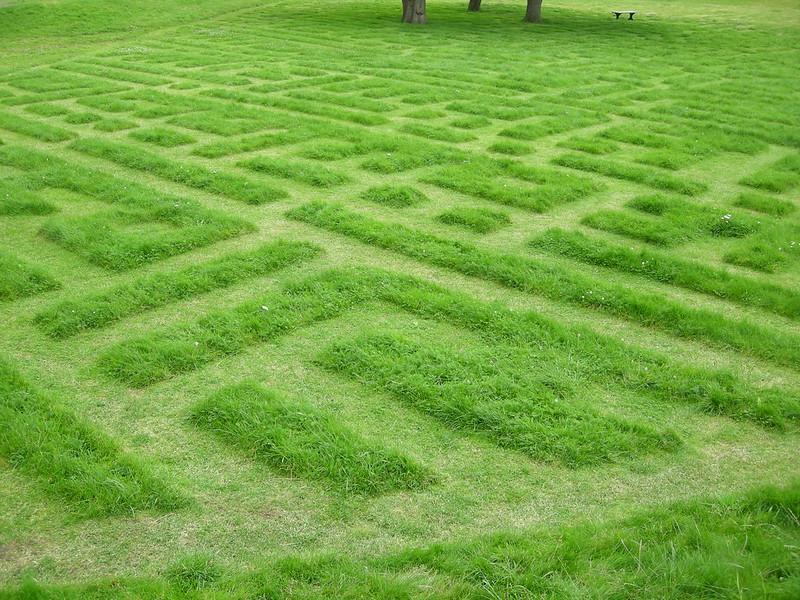
Keep your speed constant when mowing in patterns for more even lines.
Creating lawn striping patterns does not add any additional effort; however, it requires some extra thought and some preliminary planning so that you can picture what you want to do.
Nevertheless, the below-mentioned fundamental guidelines should be kept in mind regardless of the style that you select:
- Always make sure the blades on your mower are sharp to get a clean cut.
- After every two or three mowings, you should experiment with a new design or switch the direction that your stripes are going in.
- Mowing a lawn should always be done according to the three golden rules: mow dry, high, and sharp, regardless of the pattern.
- Also, regardless of the pattern you choose, keep in mind that the key to creating precise lines is to keep your mowing speed steady.
- If you want to keep your lines straight, you can use a sidewalk, driveway, or another hardscape feature in your yard as a guide.
- The answer to getting darker lawn stripes is to mow the grass taller because shorter blades don’t bend as well.
- Always ensure that there is an overlap between the stripes or rows to prevent the lawn mower from compacting the soil on the same track.
Frequently Asked Questions
What is the most straightforward pattern to mow a lawn?
When it comes to mowing your grass, lawn care professionals agree that mowing in a circle is likely the simplest and most effective pattern. This, however, may not be true for every lawn. To give you an example, if you have a square yard, mowing your grass in rows is the quickest and most effective way to get the job done.
Should you mow your grass in different directions?
Yes! Always cut your lawn in different directions. Why? Because the grass is conditioned to lean in one direction when it is repeatedly mowed in the same manner.
Additionally, when trimmed the same way, lawn mower tires can gradually compact the soil, which may result in other issues for your grass.
Is it better to mow or edge first?
When it comes to mowing and edging, there is no order that is considered to be “correct.” However, you should probably mow the grass before doing anything else. If you cut the lawn first, you will have a better idea of how short the grass should be trimmed along the margins, and you will be less likely to scalp certain areas on your lawn.
Why does my mower leave a strip of grass?
Rows or streaks of uncut grass in your lawn could be caused by dull or broken lawn mower cutting blades. Mowers leaving bare patches of grass are also commonly caused by maintenance problems. However, the most common cause of uncut grass is a dull blade.
Does frequent mowing thicken grass?
Mowing your lawn more frequently does, in fact, cause it to become thicker. Regular mowing preserves your grass in good health and encourages the growth of new side shoots, provided that you do not remove more than one-third of the top and maintain a total leaf height of at least five centimeters.
Sources For Further Reading
To Stripe or Not: Fairway Mowing Patterns. (2022). Retrieved 1 September 2022, from https://www.extension.iastate.edu/turfgrass/blog/stripe-or-not-fairway-mowing-patterns
Mowing Practices. (2022). Retrieved 1 September 2022, from https://aggie-horticulture.tamu.edu/plantanswers/turf/publications/mowing.html
Mowing practices for healthy lawns. (2022). Retrieved 1 September 2022, from https://extension.umn.edu/lawncare/mowing-practices-healthy-lawns
Mowing Lawn Turf (E0013TURF). (2022). Retrieved 1 September 2022, from https://www.canr.msu.edu/resources/mowing-lawn-turf
Editor’s Recommendations
The Best Organic Fertilizers For Home Lawns For A Greener & Healthier Yard
How To Grow Grass When You Have Dogs? A Comprehensive Guide
How To Create A Wildflower Meadow? And, Is A Wildflower Lawn Worth It?







